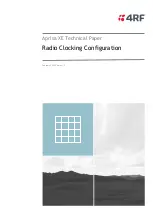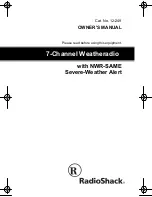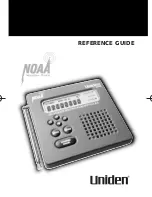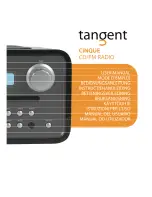
Have questions? Call
800-USA-1-USA
(800-872-1872)
or visit our website at
www.ritron.com
Possible Solution(s
)
Make sure that the battery is installed correctly,
as shown in FIG2.
Recharge or replace the battery. (Note 1.)
The radio has been dealer programmed for
customized operation consult dealer.
Move to a different location. (Note 2.)
Confirm that the proper antenna is connected to
the radio. (See p. 1, "Antenna.")
Turn Off Quiet Call (coded) squelch. (Note 3.)
Be certain your radio receives on the same
frequency as the caller transmits. (Note 4.)
Recharge the battery. (Note 1.)
Make sure your radio transmits on the receive
frequency of radio(s) you want to call. (Note 4.)
Recharge the battery.
Review the battery charging instructions.
Conserve the battery. (Note 5.)
If the radio is used in extreme cold, warm the
radio under your coat. (Note 6.)
Replace the battery. (Note 1.)
See "Error Tones" on p. 4.
Refer to "Transmitter Time-Out", p. 4.
Make sure that the channel is programmed with
Quiet Call.
Activate coded squelch. (Note 7.)
Verify the channel is programmed to detect the
same code the calling radio(s) transmits. (Note
7.)
Verify you transmit the same code as the radio(s)
you call is programmed to detect. (Note 7.)
Problem
GENERAL
The radio does not work at all.
Operating features do not work exactly as
expected.
Reception is poor.
You cannot hear calls from other radios.
Battery
Your calls cannot be heard in other radios.
The battery loses its charge sooner than
expected.
Error Tones
An error tone sounds when the radio is
first switch On.
An error tone occurs while you are
transmitting.
Quiet Call
You cannot screen out calls from outside
your QC group.
You cannot hear QC messages while in
QC (coded) squelch.
Others in your QC group cannot hear your
QC messages.
TROUBLESHOOTING
7
TROUBLESHOOTING NOTES
1. Try a battery pack from a working radio. If the radio in question works with that pack, the original
battery is suspect. Charge the suspect battery as recommended in this manual. Then, if the
charged original battery cannot power an SST-454D handheld, try charging again with another
charger. If the battery still doesn't hold a charge, the pack should probably be replaced. However,
if the battery appears to be "good" after you try the second charger, the first charger might be
faulty. If you think that an accessory is not operating properly, contact your dealer or RITRON.
2. Reception can often be improved by moving a short distance. This effect s more noticeable
inside buildings. The range of a SST-454D portable equipped with a standard battery pack is
about two miles (line-of-sight).
3. If your radio does not detect calls from other radios On the channel, turn Off Quiet Call squelch.
(Press both volume buttons at the same timea double beep means that Quiet Call squelch is
Off.)
4.
CONVENTIONAL OPERATION:
To hear a call, select a channel programmed to receive your
caller's transmit frequency. To call another unit, select a channel programmed to transmit the
other radio's receive frequency.
TRUNKED/ REPEATER OPERATION:
To operate in a repeater system, your channel(s) must be
programmed to work with the repeater's transmit and receive frequencies. (A radio channel can
hold two separate operating frequencies, one for receive, the other for transmit.)
5. Because maximum power drain occurs while the radio transmits, do not hold down the Push-To-
Talk button longer than necessary to transmit each call. Battery power is used while the
handheld is left On to receive calls. If practical, switch Off the unit.
6. In extreme cold, a battery's charge capacity is greatly reduced. If you use the radio in very cold
weather, periodically warm it underneath your coat if possible. An optional remote speaker/
microphone allows you to keep the radio under your coat while transmitting and receiving.
7. In order for radios to communicate using Quiet Call, they must be programmed with the same
Quiet Call code. Each code is unique, and your radio will respond only to the code programmed
for the channel.
Press and hold both volume buttons at the same time. A
single beep
means that Quiet Call
squelch is On. A
double beep
means that Quiet Call squelch is Off.
8
FIG3: BELT CLIP INSTALLATION
To attach the belt clip to the radio
Place the clip on the back of the radio case,
aligning the screw hole in the clip with he hole in
the case. Tighten the screw. See FIG3 at right.
CAUTION:
Use only the included Phillips head screw
,
because a longer screw could damage radio
electronics.
PHILLIPS
HEAD
SCREW
BELT
CLIP
CH
www.TwoWayRadioEquipment.com | (800) 878-7829 | [email protected]


































